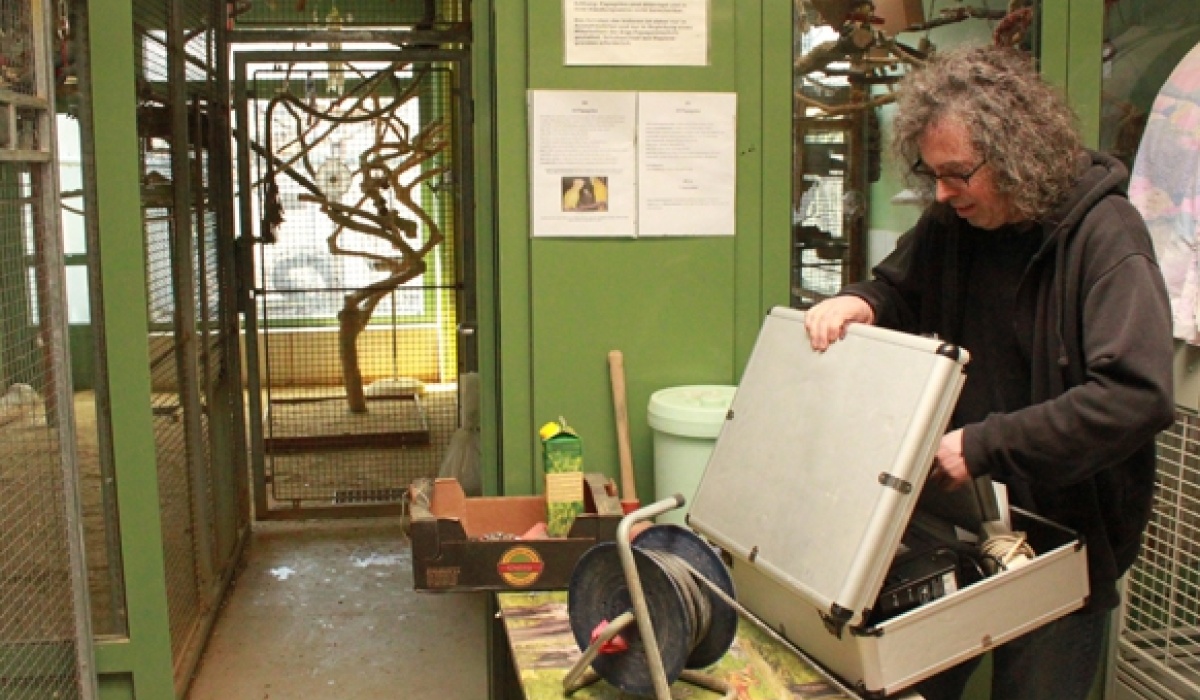
“But nobody really knows what kind of music they like, and that is what we’re here to find out,” Andrea Sodomka sums up today’s goal. “How do the birds react to rhythm, instruments, voices, electronics? What kind of sounds do they accept? Of course this is fascinating because we have no idea what is going to happen here.” And Martin Breindl adds: “These are our first attempts to communicate with the birds on a level that goes beyond baby language.”
The First Warm Day of Spring
Equipped with a computer and a loud speaker we set out on the long walk to the other side of the Vienna Animal Welfare centre. The parrot shelter is located in the building for small animals at the far end of the grounds. This time the dogs greet us with a chorus of barking. When we arrive everyone is bustling about cleaning the aviaries. Suddenly busy turns to hectic: one of the parrots has flown the coop.
Outside the office we run into the shelter’s director Catarina Güttner. Not only the fugitive parrot has caused a commotion, she explains, the birds are excited about these first warm days of spring. “The parrots, too, are experiencing a surge of hormones,” Güttner says. “In addition to spring feelings they also have more space.” Each aviary is connected to an outdoor area, where the parrots can bask in the sun, and all parrots, especially Amazon parrots, absolutely love sunshine.
A Strange, Foreign Object
Norbert Math sets up his computer and amplifier in front of the aviary of the so-called scientific group, this is the same group of parrots we got to know on our first visit (see the metamusic blog to read and hear more). We’ve placed the speaker inside the aviary, and at first the birds eyeball it sceptically. The wings of some of the parrots twitch nervously, which, as Catarina Güttner explains, indicates a tendency to flee.
Experiment No. 1: the Metamusic Jingle
They don’t actually take flight, however, so we get back to work: the first thing we play for them is an endless loop of sounds created for the metamusic jingle heard at the start of our metamusic audio features. Incidentally, the part that sounds like a Hawaiian guitar is an electronically manipulated parrot call.
The initial nervousness subsides surprisingly fast. “In a new situation parrots always need a moment to assure themselves that it is not dangerous,” Catarina Güttner comments. “They’re still not positive, but their behaviour is actually quite calm, that is to say that their reaction to other things has been much shier.” Yes, the head of the shelter confirms our impression, we have captured their attention.
Experiment No. 2: “Reflexion” by Andrea Sodomka
Next we present the parrots with an excerpt from the composition “Reflexion” by Andrea Sodomka. No change in the birds’ behaviour, they sit there listening intently. “To me it seems as if they were waiting to see what’s next,” Catarina Güttner comments. Maybe because of the similar musical mood, we whisper and start experiment No. 3: a club music track by Norbert Math.
Experiment No. 3 and No. 4
But rhythm doesn’t elicit any notable reaction from the parrots either, nor does Josef Strauss’ Dorfschwalben. A parrot’s reaction depends on the time of day, Catarina Güttner tells us. We also learn that they like to take siestas after lunch. They tend to be most active in the morning and in the late afternoon. When the sun goes down, they go to sleep. And parrots have good and bad moods and their own personal tastes.
Possible Sound Toys
We end our experiment and decide to leave a loud speaker in the aviary so our feathered friends can get used to it. As we are packing up, Norbert Math describes two ideas. He’s been thinking about building a swing that will emit sounds when a parrot sets it in motion. Or maybe the birds would have fun with a box with a row of strings hanging from it. By tugging at the strings with their beaks the birds could produce different tones. Catarina Güttner thinks both ideas are good. Almost all parrots like swings, she says, and they use their beaks to do practically everything.
An Attentive Audience
Martin Breindl was the one who got closest to the parrots today. Whereas we kept our distance, setting up our equipment off to the side so as to disturb the birds as little as possible, Breindl stationed himself right in front of the aviary. “As soon as the first sounds came out of the speakers, the birds started singing along excitedly,” the artist tells us. “It was like a chorus. Then the situation settled down and the parrots became calmer. As an audience they were actually quite attentive, the way we often wish human audiences would be.”
